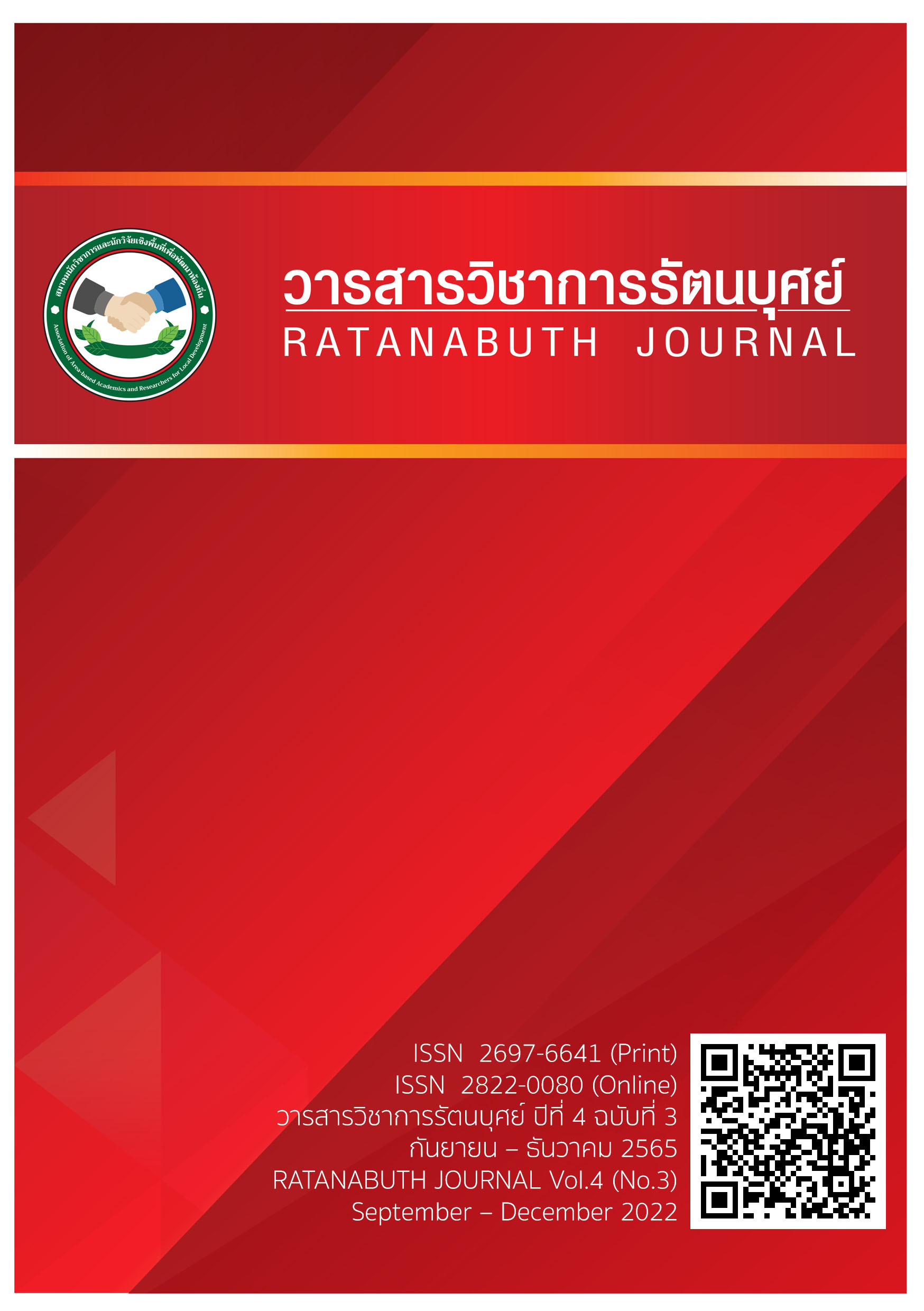Community Culture: Sustainability, Conservation for Integration of theTeaching of Civil Duty and Morals Thai Arts and Culture Unit, Phrae Technical College
Main Article Content
Abstract
Community Culture Research: Collect information that will help you determine the curriculum of the community group function. And the following example is a Thai example. Don't forget to leave Muang Phrae District. Phrae Technical College
The population and the specific sample consisted of 1) knowledge groups, i.e. people with in-depth information about cultural tourism. 2) The group of practitioners is teachers, students, villagers who have traveled. 3) The general group is the general public who have known or used to travel. This research used a qualitative cultural research method. The tools for data collection were surveys, interviews, observational forms, small group meetings and workshops.
The results of the research were as follows; 1) Tourist routes can travel locally in 3 main routes. The researcher chooses the first route which is Wat Si Chum->Wat Phrabat Ming Mueang Worawihan->Khum Chao Luang Mueang Phrae->Mueang Phrae Pillar Shrine->Khum Wichai Racha, ancient city legend of Phrae->Mueang Phrae Forestry Museum->Wat Phra Non->Ban Wongburi ->Wat Luang->Wat Hua Khuang ->Wat Chom Sawan->Seri Thai Museum->Wat Sa Bo Kaeo->Wat Si Chum, which has unique traditions and customs. There is an environment in the area to be outstanding. According to the landscape geography and history of that area activities are supported travel culturally such as, Kad Kong Khao Phrae, Phrae Walking Street. There are tourism resources of each community example, silver handicrafts. goldware and tamarind product of Ban Phra Non community, Morhom cloth of Ban Thung Hong community. It is organized in the form of demonstrations and experiments with local cooking. such as Khanom Jeen Nam Moo Phrae, Laab Mueang Phrae. 2) Integration of Civil Duty and Morals Teaching Thai Arts and Culture Unit Phrae Technical College, it has integrated in the course code 20000-1501, Civil Duty and Morals Thai Art and Culture unit on Thai culture, about Thai wisdom by using the first path, which has the following steps which has the following steps 1) Set up a committee at the school level. 2) Analyzing the learning framework, Thai wisdom, set by educational institutions. 3) Analyze the curriculum of the educational institution in order to know the focus or issues that educational institutions focus on. 4) Study/analyze information of educational institutions and communities to be used as information about Thai wisdom. 5) Prepare the learning material Thai wisdom of educational institution and to manage teaching by using worksheets, and the study of the actual place.
Article Details

This work is licensed under a Creative Commons Attribution-NonCommercial-NoDerivatives 4.0 International License.
References
ครรชิต พุทธโกษา.(2554). คู่มือการพัฒนาชุมชนแห่งการเรียนรู้ฉบับสมบูรณ์.กรุงเทพมหานคร: สำนักงานคณะกรรมการวิจัยแห่งชาติ (วช).
ทิวาวรรณ ศิริเจริญ.(2560). การออกแบบเส้นทางการท่องเที่ยวเชิงวัฒนธรรมวิถีไทหล่ม “เที่ยวไทหล่ม เมืองสงบ มากเสน่ห์”.รายงานการวิจัย สาขาวิชาการท่องเทียวและการโรงแรม คณะวิทยาการจัดการ มหาวิทยาลัยราชภัฏเพชรบูรณ์.
ในตะวัน กำหอม.(2559). การวิจัยประยุกต์ทางวัฒนธรรม เล่ม 2. กรุงเทพมหานคร: วิทยาลัยทองสุข.
พรรณเพ็ญ วัฒนมงคลลาภ.(2560). แนวทางในการพัฒนาชุมชนในเขตอำเภอเมืองแพร่ให้เป็น แหล่งท่องเที่ยวทางวัฒนธรรมอย่างยั่งยืน.การค้นคว้าอิสระ หลักสูตรศิลปศาสตรมหาบัณฑิต.
พัชรี ทองเรือง.(2560). รูปแบบชุมชนแห่งการเรียนรู้ที่ยั่งยืน.บัณฑิตวิทยาลัย.มหาวิทยาลัยราชภัฏนครศรีธรรมราช. มหาวิทยาลัยมหาจุฬาลงกรณราชวิทยาลัย วิทยาเขตนครศรีธรรมราช.
พิณสุดา สิริธรังศรี.(2555). การจัดการศึกษาแบบมีส่วนร่วมขององค์กรในชุมชน: บรรณาธิการ.ประสบการณ์จากการปฏิบัติ. กรุงเทพฯ: DPU Cool print.
ฤทัยพรรณ ทองจับ.(2564). ประเพณีชักพระ:การบูรณาการเพื่อส่งเสริมการจัดการเรียนรู้กลุ่มสาระการเรียนรู้สังคมศึกษา ศาสนาและวัฒนธรรม โรงเรียนบ้านคลองขุด สำนักงานเขตพื้นที่การศึกษาประถมศึกษา. หลักสูตรศึกษาศาสตร์มหาบัณฑิต สาขาวิชาสังคม ศาสนาและวัฒนธรรม. วิทยาลัยทองสุข.
วรนันทร์ ฉายารัตน์.(2564). “การท่องเที่ยวเศรษฐกิจตามเส้นทาง EEC”: พื้นที่เขตพัฒนาพิเศษภาคตะวันออกเพื่อบูรณาการการสอนกลุ่มสาระสังคมศึกษา ศาสนาและวัฒนธรรมโรงเรียนนิคมสร้างตนเองจังหวัดระยอง. หลักสูตรศึกษาศาสตร์มหาบัณฑิต.สาขาวิชาสังคม ศาสนาและวัฒนธรรม.วิทยาลัยทองสุข.
วรวิทย์ นิเทศศิลป์ และชวลิต ขอดศิริ.(2560).การบูรณาการการเรียนการสอนด้วยวิธีการทำนุบำรุงศิลปวัฒนธรรมท้องถิ่นล้านนา.วิทยานิพนธ์ สถาบันวิจัยพุทธศาสตร์ มหาวิทยาลัยมหาจุฬาลงกรณ์ราชวิทยาลัย.
เสรี พงศ์พิศ.(2551). คืนสู่รากเหง้า: ทางเลือกและทัศนะวิจารณ์ว่าด้วยภูมิปัญญาชาวบ้าน.กรุงเทพมหาคร: เทียนวรรณ.
สำนักงานเลขาธิการสภาการศึกษา.(2551).การพัฒนาตัวชี้วัดประสิทธิภาพการจัดการเรียนรู้ของสถานศึกษาในระดับการศึกษาขั้นพื้นฐาน.กรุงเทพมหานคร : บริษัท พริกหวานกราฟฟิค
Hong, P.Y., A. Sheriff and S. Naeger. (2009). A Bottom-up Definition of Self- sufficiency:Voices from Low-income Jobseekers. Oualitative Social Work. 8(3): 357-376.


